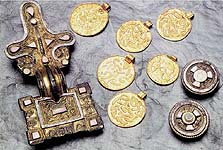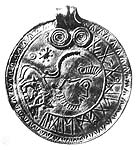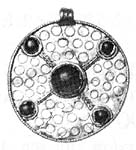 |
||||||||||||||||||||
|
Lesson #5: Page 6
Beads
More unusual materials include: amethyst, crystal, jet, stone, clay, bone, cherry pips, bits of roman tile, chalk, in fact almost anything! They were not usually arranged according to size, shape or colour. Strings of beads were not normally worn like modern necklaces (except perhaps in Kent), rather they were suspended in festoons on the front of the body. The strings of beads were normally attached to the shoulder brooches, but a central brooch was sometimes fastened over them, keeping the festoon in position. click on image for larger version in new window
Beads also sometimes decorated girdles, and may also have been sewn, in small clusters, onto garments. Single beads may also have been used to fasten head-dresses, and sometimes small strings of beads are found at the back of the head, probably holding the hair in a bun or ponytail. In rare cases bead bracelets were worn, and very rarely, bead anklets are known. The number of beads worn varied greatly, from single beads to over one hundred (a few women had over 400!). Generally, women well equipped with brooches had the most beads, and the number seems to increase with age suggesting bead necklaces were constantly added to throughout a woman’s life. The beads were generally strung on linen thread, often plaited or made into a cord. Click on image for larger version in new window
Bracteates and Coin-Related
Pendants
True bracteates are indicative of a Scandinavian origin, although many were produced in England, particularly in Kent, from the fifth to the seventh century. Quite a few Roman coins have been found pierced and used as pendants on Anglo-Saxon necklaces. Meaney has argued persuasively that Roman coins worn as pendants by Anglo-Saxon women may have been imbued with amuletic properties. click on image for larger version in new window
Jewelled Pendants
Some of these pendants resemble bracteates or scutiform pendants in their disc-shaped outlines and ribbed suspension loops, but the inspiration for others, with their gem-filled cloisons and filigree decoration, seems to have come instead from the jewelled disc-brooches of applied plate type discussed earlier. In fact some seem almost as though they may have been adapted from detached plates from such brooches, but the central cell (invariably forming a void in the case of brooch plates, so as to fit over the cell itself formed on the back-plate) is here made as a cloison soldered onto the base-plate; the inlay rarely survives but is likely to have been the same white material used in brooches. As might be expected from the distribution of the brooches, these pendants are generally of Kentish origin, and are of the late sixth- to early seventh-century. Another type of jewelled pendant is the cabochon or ‘drop’ pendant. These appear in the seventh century and were probably not worn with Pagan style clothing. click on image for larger version in new window
Other Pendants
The delicate scutiform pendants contrast with the cast copper-alloy pendants with stylized zoomorphic heads as their main decorative feature. They are generally bell-shaped or oval in outline. Often old Roman brooches (perhaps found in the ground or ruins), finger-rings and Frankish or Byzantine ear-rings were used as pendants by Anglo-Saxon women. It is unclear if, in the case of ear-rings, this was in ignorance of their proper function. Other types of pendants, some deliberately made, others improvised, are known in a wide variety of forms. click on image for larger version in new window
Click here for more pictures of pendants
|
||||||||||||||||||||
| Costume
Classroom is a division of The
Costume Gallery, copyright 1997-2001.
Having problems with this webpage contact: questions@costumeclassroom.com |
||||||||||||||||||||










